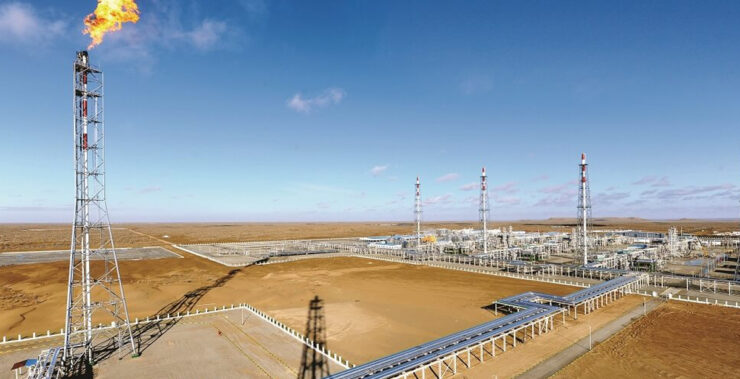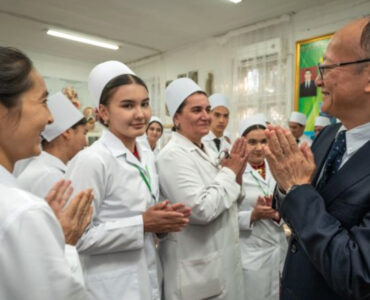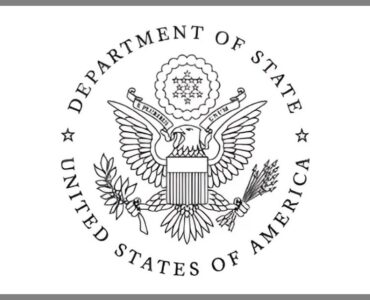In 2014, the World Bank published a comprehensive 66-page report titled “Turkmenistan – Diversifying the Turkmen economy”. Turkmen economy is dependent on the exports of natural gas and there have been multiple attempts to diversify the economy. The World Bank report argues that successful diversification can be achieved if the Turkmen government creates the conditions for building a balanced portfolio of three national assets – natural resource management, human and physical capital, and national institutions.
Natural Resources
Turkmenistan’s economy is heavily reliant on its abundant natural resources, particularly natural gas:
- Extractive industry: The extractive industries contributed approximately 35% to the country’s GDP and accounted for over 90% of total exports and ensured 85% of the budget revenues in 2013.
- Export and Employment Dynamics: Despite the extractive sector’s significant contribution to GDP and exports, it employs only about 2% of the labor force. This stark contrast highlights the limited direct employment opportunities in the sector, compared to the nearly 50% of the workforce employed in agriculture.
- Volatility Risks: The economy’s reliance on hydrocarbons exposes it to global market fluctuations. For instance, favorable external conditions, such as high hydrocarbon prices, have previously fueled growth. However, this dependence also makes the economy susceptible to downturns in global commodity prices, impacting savings, investment, and government revenue stability.
- Resource management: The Stabilization Fund, created in 2008, is a key tool for managing resource revenues. However, there is a need for more transparent and objective criteria in utilizing these funds.
Human and Physical Capital
Both physical infrastructure and human capital are crucial for sustainable economic growth.
Physical Capital
- Infrastructure Investment: between 2009-2014, Turkmenistan’s investment rates have been among the highest globally, averaging around 47-48 percent of GDP. Revenue from hydrocarbon exports enabled substantial investments, particularly in public infrastructure projects. In 2012 alone, total investments reached 48.4 billion Manats (approximately 17 billion USD). Of this, 77.6% came from public sources, 15.6% from foreign investments, and a mere 6.8% from private investors.
- Sectoral Distribution: A significant portion of these investments is directed towards the hydrocarbon industry, with 46.1% of public funds and 85.2% of foreign investments allocated to this sector. In contrast, investment in critical areas like health and education remains low, at 2.9% and 3.1% of total investment, respectively.
- Information and Communication Technology (ICT) and Connectivity: The country’s ICT infrastructure is underdeveloped, with only 7 internet connections per 100 people and 3 fixed broadband internet subscribers per 10,000 people as of 2012. This low penetration rate limits the potential for business growth and integration into global value chains.
Human Capital
Donate to support Turkmen analysts, researchers and writers to produce factual, constructive and progressive content in their efforts to educate the public of Turkmenistan.
SUPPORT OUR WORK- Public Expenditure on Social Sectors: Turkmenistan allocates around 5-6% of its GDP to social sectors, including education (3-4%) and healthcare (1%). This is relatively low compared to international standards, where governments typically spend 5-10% of GDP on these sectors.
- Education and Workforce Development: The country faces a growing need to improve the quality and quantity of education to align with economic demands. With a labor force participation rate of 61% for those aged 15-64 and employment rates around 55%, there is significant potential to enhance workforce skills and productivity.
- Health Indicators: Despite increases in per capita income, health outcomes, such as life expectancy, lag behind regional and global comparators. Improving health services is essential to support a productive and innovative workforce.
Institutions
Strong national institutions are crucial for managing the economy, ensuring transparency, and fostering a competitive environment:
- Governance Structure: Turkmenistan operates under a highly centralized governance model, characterized by strong presidential control and top-down decision-making. This structure often results in limited public participation and challenges in policy implementation.
- Regulatory Framework: The country lacks a comprehensive competition authority, and regulatory quality is a significant concern. Inconsistent enforcement of laws and regulations, as indicated by low scores in the World Bank’s Worldwide Governance Indicators, hampers business operations and discourages foreign investment.
- Public Service Delivery and Coordination: The public administration faces capacity constraints and coordination challenges, leading to fragmented regulation and sub-optimal service delivery. Enhancing these systems is critical for effective governance and economic management.
- Economic policy: The fixed exchange rate, set in 2009, limits monetary policy flexibility, potentially leading to currency overvaluation and impacting competitiveness.
- Private Sector Development: The authorities might consider adopting a private sector development model that grants private entrepreneurs more autonomy in decision-making, particularly concerning production and location choices. This approach should be applied to both newly established firms and privatized enterprises.
Conclusion and Recommendations
For successful diversification the government of Turkmenistan should be:
- Enhancing Natural Resource Management: Implement transparent fiscal rules for managing resource rents, including the utilization of the Stabilization Fund to support sustainable fiscal policies.
- Investing in Human Capital and Infrastructure: Increase investment in health and education to build a skilled workforce. This includes improving the quality of education to meet the needs of a modern economy and expanding access to healthcare services.
- Strengthening Institutions: Develop a comprehensive regulatory framework that fosters competition and supports private sector growth. Establishing a competition authority is crucial to ensure a level playing field for all businesses.
By focusing on these areas, Turkmenistan can reduce its dependence on hydrocarbons, diversify its economy, and promote sustainable growth. Balancing the development of natural resources, human capital and national institutions will help the country build a robust, diversified economic base, capable of withstanding external shocks and providing stable employment opportunities.






